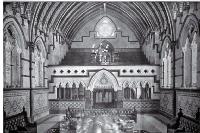Captain James Cook sighted Banks Peninsula on 16 February 1770. He wrongly supposed it to be an island and did not land.
Sealers and whalers
It was not until late 1809 that the first European entered Lyttelton Harbour in the sealer "Pegasus". Captain Chase gave the name of his vessel to Pegasus Bay. About 1815 the first European landed in Canterbury from another sealing ship, the "Governor Bligh". By 1835 the first whaling ships were operating out of Lyttelton and two years later the first shore whaling station was set up at Peraki Bay.
First settlers
The "Sarah and Elizabeth" on 12 April 1840 landed Messrs Herriott, McGillivray, Ellis, Shaw (and his wife) and McKinnon (with his wife and children) - the first European settlers on the plain. By early 1841 this party had abandoned its attempt to establish a farm near what is now Hagley Park.

Canterbury Pilgrims
In 1850 the 800 or so settlers, already known as the Canterbury Pilgrims, arrived at Lyttelton as the pioneers of organised European settlement in Canterbury. They came in four ships: the Charlotte Jane and the Randolph on 16 December 1850 Sir George Seymour the following day, and the Cressy on 27 December. The settlement had been planned well before their arrival however. On 15 December 1848 Captain Joseph Thomas, who had been selected by the Canterbury Association in England as its agent, arrived at Port Cooper which he loyally labelled Port Victoria. Common usage of "Lyttelton Harbour" was, in 1857, officially recognised, and became Port Lyttelton.
Establishing Christchurch
The first proposal was to establish the capital, Christchurch, at the head of the harbour beyond Governor's Bay while Port Lyttelton was to be further up the harbour near the Māori settlement of Rapaki. The cost of reclaiming the harbour shallows became apparent; this and the advantage of having the capital within easy reach of the farmlands and the claim by the Māori that Rapaki should be one of their reserves changed Thomas's mind. In addition, within a fortnight of the arrival of the Charlotte Jane, the Society of Land Purchasers agreed that the capital should be on the plains rather than in Erskine Bay to which Thomas had switched the port. An alternative site was at hand.
Naming Christchurch
The Deans brothers had already named the River Avon after the Lanarkshire stream which rose in the Ayrshire hills near their grandfather's farm. The proposal to place a subordinate town on the Avon and call it Stratford arose from an association with a quite different Avon - that in Warwickshire, known to Shakespeare. By coincidence, Christchurch, Dorset (our sister municipality) is also situated on a River Avon and this had led to the mistaken assumption that Christchurch, New Zealand, is named after Christchurch, Dorset.

Christ's College (named after the Cambridge College of Godley's lieutenant, J.E. Fitzgerald) was, in fact, ultimately established in Rolleston Avenue, after its reserves in Cathedral Square were exchanged for six acres in the Government Domain. Beginning in Lyttelton in April 1851 as the Collegiate Grammar School and moving to S. Michael's vicarage a year later, Christ's College was intended as the junior half of a planned complete education system, the proposed Christ Church College being the university portion.
Christchurch became a City by Royal Charter on 31 July 1856 by virtue of having become an English See under letters patent. It can therefore, justly claim to be the oldest City in New Zealand, preceding Nelson in this distinction by two years.
Christchurch and Canterbury Governance

The first meeting of the Christchurch Municipal Council was held on 3 March 1862. In November of that year it became the Christchurch City Council by virtue of the Christchurch City Council Ordinance, but between June and October 1868, was known as the Christchurch Borough Council in compliance with the Municipal Corporations Act passed by Parliament in November 1867. An amending Act in September 1868 enabled the Corporation to reassume the name of Christchurch City Council.
The City Grows
The original Municipal District had as its boundaries (to describe them by the present names) - on the north, Bealey Avenue; on the south, Moorhouse Avenue; on the east, Fitzgerald Avenue; and on the west Antigua Street, Rolleston Avenue and Park Terrace. The population at the time was 3,205. The land between Antigua Street and Hagley Avenue, north of Moorhouse Avenue, was added in 1863 to make the area of the City 1,249 acres.
Since that time progressive amalgamations enlarged the city to the 1989 pre-reorganisation size of 10,635 hectares. The newly constituted Christchurch City came into existence on 1 November 1989 covering 45,249 hectares. It includes the territories of the former Christchurch City Council, Waimairi District Council, Riccarton Borough Council, Heathcote County Council and parts of Paparua County Council, Rangiora District Council and Eyre County Council. The City, roughly circular in pattern with a radial network of roads, is bounded by the Port Hills to the south and the Pacific Ocean to the east. The northern boundary of the city is defined by the Waimakariri River.
Christchurch City is the largest urban centre in the South Island and has the second largest population of all New Zealand's territorial local authorities. In March 1996, the City had an estimated resident population of 309,000 people. In the last four years the city's population has risen sharply. Current population growth is unprecedented since the early 1960s.
More information
Related pages
Sources
This was originally derived from the Christchurch City Council handbook of 1998.

